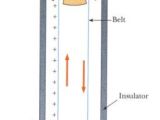You might confuse a Van de Graaff generator with the Tesla coil from time to time, due to certain features that make them resemble, however they are two different instruments producing different effects. A Tesla coil is a type of resonant transformer invented by Nicola Tesla, which produces high voltages and very high frequencies used to create atmospheric disruptive discharges similar to lightning, while the Van de Graaff generator is used to produce high voltage electrostatic charge, and acts in the same way as a capacitor.
Originally designed in the early 1930s, by the American physicist Robert Jemison Van de Graaff, the Van de Graaff generator was created to provide with extremely high voltages, used in the first particle colliders to accelerate elementary particles to high speeds, in order to study nuclear physics. They are commonly known as 'constant current' electrostatic devices, as they provide steady current at the output terminal.
They work on the basis of gathering static charges. The static charges are mostly produced in insulators and semiconductors, due to the fact that their electrons cannot move freely through the whole material, as those inside conductors. Most materials have neutral charges, however when rubbing together two different tribomaterials, silk and a PVC tube, for example, the weak bonds between the silk atoms and its electrons are broken and electrons are passed to the PVC tube, meaning that the silk has become charged positively, whereas the PVC negatively.
Van de Graaff generators use a simple construction that allows them to high voltage charges, which can get as high as twenty million volts. Their basic design consists of two rollers set at a distance apart that rotate freely of separate axes, on which a rubber belt is being circulated. The surface of the belt is being brushed by two brushes consisting of thin metal wires, which sweep the area of the two rollers. Both are usually built from pieces of nylon, however the inferior roller must be covered with a silicon tape.
The output terminal connects to the superior brush and, most of the times, it consists of a metal or aluminum hollow sphere, which will provide the medium on which the electric charge will build up. The whole mechanism is put into action with the help of a small motor that rotates the inferior roller, which could probably average about 1000 rotations per minute, in order for the generators to work efficiently.
As the rubber belt is being circulated on the roller, the brushes sweep the area of the belt, gathering positive electric charge in the spherical output terminal, which builds up the voltage, while the negative charge is evacuated to the ground. When the breakdown voltage between the terminal reaches a critical value, the potential of the two tend to cancel each other and an electric spark is produced between them.
The charges of the two terminals can be reversed if necessary, in order to obtain the desired effect. There are probably countless experiments that are using Van de Graaff generators and a vast number of such devices all over the world, since they are extremely easy to manufacture and can be home built in a few minutes if the required materials are available.

 14 DAY TRIAL //
14 DAY TRIAL // 
